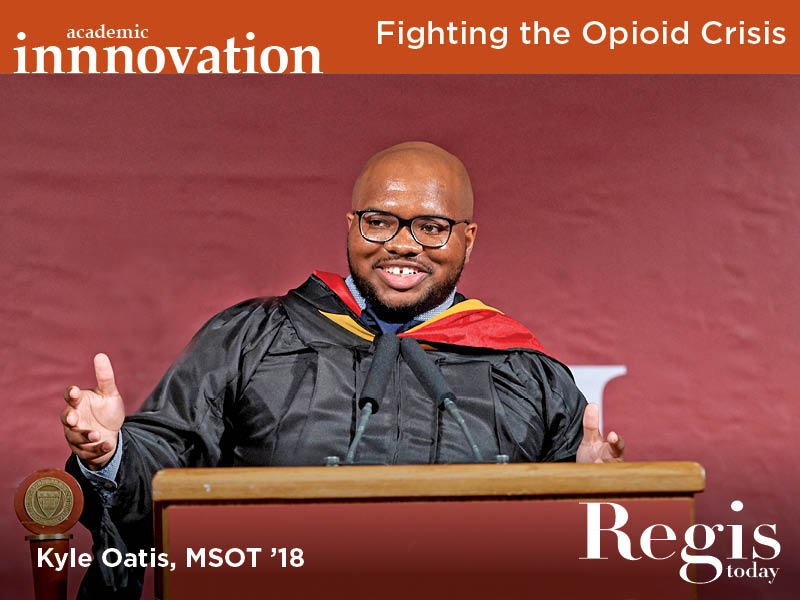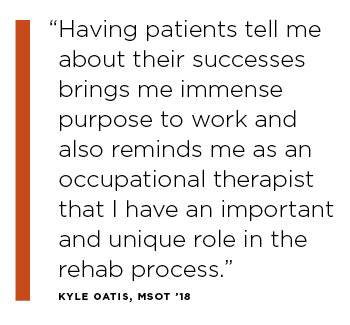
BY KRISTEN WALSH
When Kyle Oatis, MSOT ’18 chose to become an occupational therapist, he wasn’t thinking that his work would help impact the opioid crisis. But after about a year on the job—treating hands and upper extremity injuries like broken wrists, elbows, and fingers—he was invited to attend an American Occupational Therapy Association meeting to advocate for the importance of including occupational therapy in the new legislation regarding essential services for non-pharmacological care. And that got him thinking.
“Prior to speaking with my local senator, I reflected on the impact I have on my patients regarding this issue and I realized how invaluable it was,” recalls Oatis, who works at nMotion Hand and Physical Therapy, an outpatient clinic in Marietta, Georgia. “As an occupational therapist treating hand and upper extremity, a large bulk of my patients present to the clinic with high pain levels. Some conditions such as post-surgical pain, chronic conditions like arthritis and tendonitis, and traumatic accidents leading to sprains and fractures leave patients with not only increased pain levels but also decreased abilities with performing the daily activities they consider to be essential.”
Many of Oatis’ patients try to avoid taking stronger prescription drugs for their hand and wrist, even if they are prescribed. Of particular concern is the risk of developing an opioid addiction or relapsing from a substance use disorder. It’s not surprising, given that the opioid crisis has been called the most perfect illustration of the cure being worse than the disease. The Centers for Disease Control and Prevention reports that as many as one in four patients receiving long-term opioid therapy in a primary care setting struggles with opioid addiction.
Oatis provides an alternative, utilizing modalities, manual techniques, education on compensatory strategies, adaptive techniques, and graded activities to assist patients with pain reduction and help them return to the activities that are most meaningful to them such as shaving, making it through a yoga class, and playing the guitar.
“Having patients tell me about their successes,” Oatis says, “brings me immense purpose to work
and also reminds me as an occupational therapist that I have an important and unique role in the rehab process.”
In 2018, the Substance Use-Disorder Prevention that Promotes Opioid Recovery and Treatment (SUPPORT) for Patients and Communities Act included occupational therapy as a non-pharmacological pain management treatment.
BUILDING CONFIDENCE
Oatis first took an interest in treating injuries during high school. As a defensive tackle on the Parkview High School football team in Lilburn, Georgia, he wasn’t only concerned with rushing the passer or blocking a running play.
“I would watch our team therapist assess injuries and help get my teammates back on the field, which led me to want to learn more about rehabilitation,” Oatis says. “I had the opportunity to shadow a hand therapist in Hattiesburg, Mississippi, who introduced me to occupational therapist and I fell in love.”
It was shortly after that he met Marvin Williams, a school-based therapist and pediatric practice owner in Madison, Mississippi, who became his mentor. “I quickly realized how wide my scope could be as an occupational therapist and I decided without a doubt that it was the profession for me.”
Oatis moved to Boston after receiving a job offer to work in a long-term acute-care hospital where he could gain more experience and knowledge. While exploring occupational therapy programs, he met Michael Roberts, OT, OTD, associate professor and director of the Regis master’s program in occupational therapy. Ten minutes later, Oatis says he was sold. “Dr. Roberts had a vision for the program that placed an emphasis on turning out practitioners who were self-aware, compassionate, and educated.”
It’s something that informs Oatis’ work at nMotion. He uses techniques he learned at Regis to help patients gain strength and confidence. Grading tasks, for example, entail increasing or decreasing the difficulty of an activity to meet that patient’s capabilities: starting with light weightlifting activities (one to two pounds)—carrying boxes and pushing carts—and adding a few pounds every week. He also uses modalities such as TENs (transcutaneous electrical nerve stimulation), which utilizes low voltage electrical current to provide pain relief.
“During the treatment process, I always make sure to check in with patients’ pain levels to respect and adjust anything out of their comfort zone,” Oatis says.
Roberts, who is host of the widely respected I Love OT Podcast, isn’t surprised at Oatis’ success, including his appointment to the executive board of
the Georgia OT Association.
“Kyle’s potential as a leader and model practitioner was evident from the first time I met him,” Roberts says. “He has always balanced professionalism with an accessible and caring personality. As our first student OT association president, I was equally proud to introduce him to leaders in our profession at the national American Occupational Therapy Association conference and to see the way he worked to bring our diverse student body together.”
The pair share a mutual respect. “I will never forget Dr. Roberts’ emphasis throughout the program to always look at our clients holistically,” Oatis says. “Everyone is a sum of our perception, our environment, our character, our roles, our abilities, and our dreams, and all of these things directly play into our function. This helps me daily to remember to always make my work client-centered and meaningful for whomever I come in contact with.”
It also informs something that Oatis continually asks himself: “As an occupational therapist, what’s my role in the opioid epidemic?”
His answer: “Though we may not be considered to be on the front lines as health care practitioners in the opioid epidemic, occupational therapists play an immensely large role in helping serve the community when it comes to combating opioid addiction.”
Read more articles
Read the entire magazine online